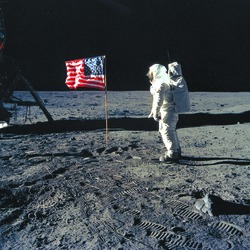
Buzz Aldrin stands before the U.S. flag at the Sea of Tranquility. Photo Credit: NASA
On Sunday, 20 July 1969, the Mission Operations Control Room (MOCR) at NASA’s Manned Spacecraft Center (MSC) in Houston, Texas, was filled with tension and expectant quiet. More than three billion people lived on Earth and three others—Apollo 11 astronauts Neil Armstrong, Mike Collins and Edwin “Buzz” Aldrin—occupied an environment far more distant, far more hostile and far more exotic. Leaving Collins behind in lunar orbit aboard the command and service module Columbia, Armstrong and Aldrin descended in the lunar module Eagle and alighted smoothly on the surface of the Moon. Against all the odds, a perfect touchdown on alien soil had been accomplished on the Sea of Tranquility, and the time rapidly approached when they would take the steps which would earn them immortality: the first “Moonwalk.”
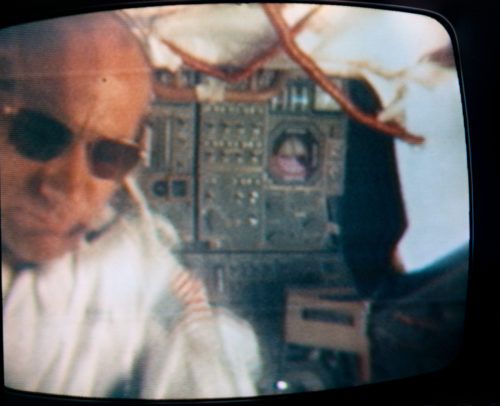
Pictured here during the trans-lunar coast, Buzz Aldrin would spend a few moments on the Moon celebrating Communion. Photo Credit: NASA
For the first time in four days, Armstrong and Aldrin could now feel something of their Earthly weight—albeit a mere sixth of it—as the weak lunar gravity took its toll. It enabled Aldrin to celebrate Holy Communion. Opening a personal stowage pouch, given to him by his Presbyterian minister, Reverend Dean Woodruff, he pulled out a tiny wine flask and chalice and a handful of wafers and put all three on Eagle’s small keypad. “This is the LM Pilot speaking,” he said at 5:57 p.m. CDT on 20 July 1969, two hours after landing. “I’d like to request a few moments of silence. I’d like to take this opportunity to ask every person listening in, whoever and wherever they may be, to pause for a moment and contemplate the events of the past few hours, and to give thanks in his or her own way.” Upturning the flask, Aldrin watched as the wine curled its way, sluggishly, into the chalice. In silence, he read from the Book of John:
I am the vine and you are the branches
Whoever remains in me and I in him will bear much fruit
For you can do nothing without me
There was much to do. After confirming that Eagle was undamaged, the conservative flight plan called for the astronauts to take a four-hour nap before beginning preparations for the Moonwalk. This was about as likely as telling a child to sleep on Christmas morning. In the weeks before the launch, the idea of skipping this brief sleep period and proceeding directly into “EVA Prep” had been discussed and when Armstrong formally requested it at 5:11 p.m. CDT it did not take long for Capcom Charlie Duke to respond with Mission Control’s full approval.
“Houston, Tranquility?”
“Go, Tranquility. Over.”
“Our recommendation,” said Armstrong, “at this point is planning an EVA—with your concurrence —starting about 8 o’clock Houston time. That is about three hours from now.”
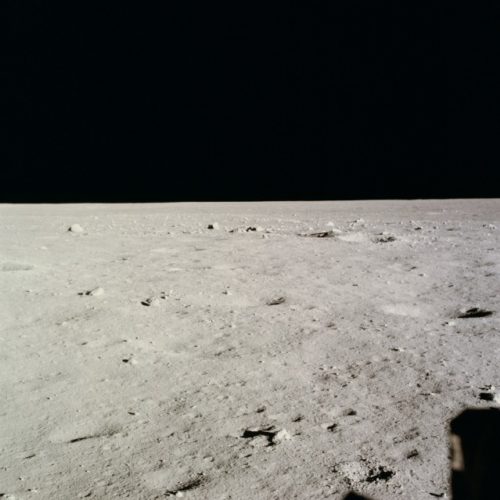
An early view of Tranquility Base through Eagle’s window. Photo Credit: NASA
“Stand by,” said Duke, turning to Flight Director Gene Kranz. Notwithstanding the 2.6-second time delay as radio signals crackled back and forth across the 240,000-mile (370,000-km) cislunar gulf, Duke’s next words reached the astronauts just nine seconds after Armstrong made his request.
“Tranquility Base, Houston. We thought about it. We will support it.”
Donning of their lunar surface equipment was far more complex than it had been in Earth-bound simulations and was not aided by the fact that Eagle’s tiny cabin was filled with checklists, food packages, stopwatches and other assorted equipment. Armstrong and Aldrin spent an hour preparing their gear, then three hours putting it on: rubber-soled lunar overshoes, backpacks, oxygen hoses, coolant umbilicals, outer helmets, chest-mounted control units; the list went on. In his 1989 autobiography, Men from Earth, Aldrin described them as like a pair of fullbacks in a Cub Scout tent, whilst Armstrong told his biographer, James Hansen, that it was “pretty close in there, with the suits inflated.”
After a brief struggle to open Eagle’s hatch, the men were exposed to vacuum as the last vestiges of air rushed out in a flurry of ice crystals. At once, Armstrong clumsily dropped to his knees, his head facing the back of the cabin, his feet inside the yawning square opening that marked the threshold to a dream which had captivated humanity for thousands of years. His backpack extended to some height, and he had to move delicately to avoid causing damage. At length, he was on the lunar module’s porch and was reminded by the duty Capcom, astronaut Bruce McCandless, to pull a lanyard to deploy a black-and-white television camera to monitor his descent to the surface.
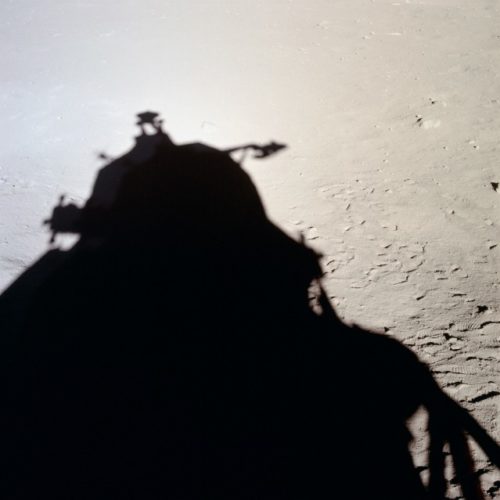
Silhouette of Eagle against the barren lunar terrain. Photo Credit: NASA
The images—replayed so many times over the decades—still retain their ethereal quality as the first record of our footsteps into the Universe around us. Armstrong was difficult to see in Eagle’s shadow, but the bright plain of the Sea of Tranquility and the black sky could be easily discerned. Descending the nine-rung ladder was by no means dizzying, and he felt so light that he dropped with the grace of a snowflake down each step and into the footpad. To check his abilities, he sprang back up to the first rung, then returned to the footpad. Glancing around, he told his terrestrial audience what he saw: “The surface,” he began at 9:55:38 p.m. CDT, “appears to be very, very fine-grained as you get close to it. It’s almost like a powder.”
Thirty-seven seconds later, the first man set foot on the Moon.
According to NASA’s official flight transcript, the epochal moment came at 9:56:15 p.m. CDT, when he raised his left boot over Eagle’s footpad and planted it on the lunar soil. Seconds later came the historic words: “That’s one small step for man…one giant leap for mankind.”
In those few steps, he tested his weight and found that he could pick up the soil loosely with his toe; it adhered to the soles and sides of his boots like layered charcoal. The prints imprinted the surface only slightly, but left clear impressions, and moving around in one-sixth of terrestrial gravity felt entirely natural. (Armstrong’s mother, Viola, watching his steps on television, described him as “buoyant” and “almost floating”—an entirely appropriate choice of words, both figuratively and literally.)
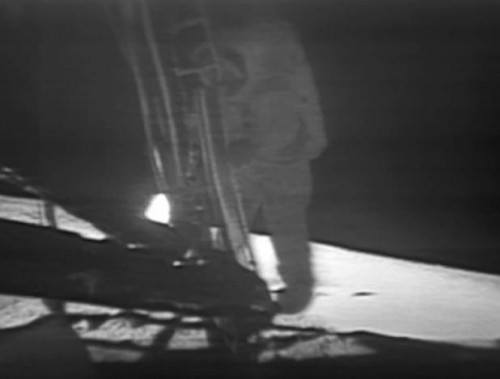
Humankind’s greatest achievement was broadcast live on TV, courtesy of NASA’s Deep Space Network. Image Credit: NASA
Eagle’s descent engine had left no appreciable crater, although erosive “rays” on the surface illustrated the effect of its impulse, just prior to touchdown. Next came the arrival of the large Hasselblad camera, via the clothesline-like Lunar Equipment Conveyor, and Armstrong became so engrossed in photographing the hinterland of Tranquility that he almost forgot to collect a contingency sample of soil. It took Aldrin and Bruce McCandless a couple of calls to remind him. Digging the sample was a strange sensation: Although the upper layer of the surface was soft, he very quickly ran into a hard, very cohesive material. “It has a stark beauty of its own,” he remarked, “much like the high desert of the United States. It’s different, but it’s very pretty out here.”
Sixteen minutes into the Moonwalk, it was Aldrin’s turn to venture outside, and this enabled Armstrong to use the Hasselblad to acquire dramatic images of his crewmate departing Eagle and taking his first steps.
As he looked around, two words came to mind: Magnificent desolation. “Nothing prepared me for the starkness of the terrain,” Aldrin recalled later. “It was barren and rolling and the horizon was much closer than I was used to. Earth’s diameter is such that its inhabitants have no personal awareness of the curvature; it’s easy to understand why, for centuries, it was believed to be flat…but on the smaller Moon, my impression was that we were on a ball, or on the knoll of a hill. I even felt a bit disorientated because of the nearness of the horizon.”
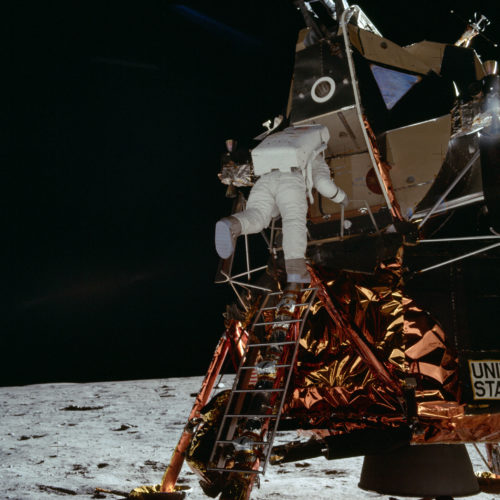
Buzz Aldrin’s descends Eagle’s ladder to the surface. Photo Credit: NASA
As they walked, Armstrong found that the most “natural” gait was a loping motion, in which he alternated feet, pushed off with each step, and floated ahead, before planting the next foot. Others included a kind of “skipping stride” and a “kangaroo hop.” Although the weight of their backpacks was reduced by five-sixths on the Moon, its effect on their balance meant that they were always slightly pitched forward as they walked; and when Armstrong jumped he felt a tendency to tip over backward as soon as he landed. They had to take care in turning and halting. “I noticed immediately,” Aldrin recounted in Men from Earth, “that my inertia seemed much greater. Earthbound, I would have stopped my run in just one step…an abrupt halt. I immediately sensed that if I tried this on the Moon, I’d be face-down in the lunar dust. I had to use two or three steps and sort of wind down. The same applied to turning around…on Earth, it’s simple, but on the Moon, it’s done in stages.”
Having assured themselves of a more-or-less solid footing on alien soil, the astronauts’ next task was to unveil a commemorative plaque on the strut of the lander that held the ladder. At 10:24 p.m. CDT, less than half an hour after setting foot on the surface, Armstrong described the plaque to his television audience.
As Apollo 11 was an American venture, and paid for by the American public, but one undertaken in the name “of all mankind,” the problem of what kind of flag to plant on the Moon arose frequently in the months before launch. Some felt that the flag of the United Nations was appropriate, but others argued with equal vigor for the Stars and Stripes. At President Nixon’s inauguration six months earlier, he had spoken of going “to new worlds together…not as new worlds to be conquered, but as a new adventure to be shared.” Was he hinting that a United Nations flag should be raised on Apollo 11? Some spectators believed so, and it was perhaps with this in mind that in February 1969 newly appointed NASA Administrator Tom Paine formed a Committee on Symbolic Activities for the First Lunar Landing to determine how one of the most historic events in human history should be marked. The committee heard convincing arguments in favor of a UN flag and in favor of depositing a collection of miniature flags of all nations, but finally it decided that the Stars and Stripes would be erected.
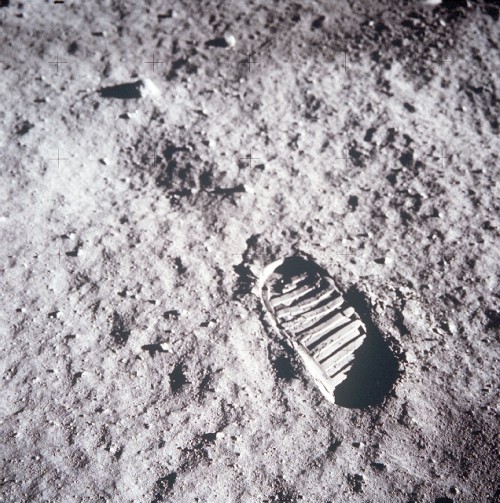
One of the iconic images from Apollo 11 was Buzz Aldrin’s photograph of his own bootprint in the ancient lunar soil. Photo Credit: NASA
When NASA formally notified members of Congress on 10 June 1969 that it intended to raise the national flag on the Moon, its appropriations bill for the next fiscal year was immediately approved. Later in the year, when the final version of the $3.7 billion bill was agreed by a House and Senate conference committee on 4 November 1969, a provision stated that “the flag of the United States, and no other flag, shall be implanted or otherwise placed on the surface of the Moon, or on the surface of any planet, by the members of the crew of any spacecraft…as part of any mission…the funds of which are provided entirely by the Government of the United States…” It was, indeed, a symbol of national pride.
The development of the flag is a long and intriguing story in itself, but the photographs which Armstrong took of Aldrin snapping a smart military salute, against the backdrop of the desolate lunar surface, proved to be some of the most iconic. Yet Armstrong’s absence from most images has been described by James Hansen as “one of the minor tragedies of Apollo 11.” Over the years, outrageous claims have been made that Aldrin “intentionally” avoided taking direct photographs of his commander on the Moon, with some even ludicrously pointing to a perceived bitterness over losing the chance to be first on the surface. In reality, of course, both men were outside Eagle for little more than two hours and virtually every minute of that time was spent on assigned tasks: getting the contingency sample, unveiling the plaque, erecting the flag, deploying a pair of instruments, and conducting geological inspections and taking specimens.
Having said this, the primary reason that there were so few images of the First Man was because Armstrong had possession of the Hasselblad for most of the time. “As the sequence of lunar operations evolved,” Aldrin wrote later, “Neil had the camera…and the majority of the pictures taken on the Moon that include an astronaut are of me. It wasn’t until we were back on Earth and in the Lunar Receiving Laboratory, looking over the pictures that we realized there were few pictures of Neil. My fault, perhaps, but we had never simulated this during our training.” For his part, Armstrong cared little about who took pictures of whom, as long as those pictures were good. “I don’t think Buzz had any reason to take my picture,” he told James Hansen, “and it never occurred to me that he should.”
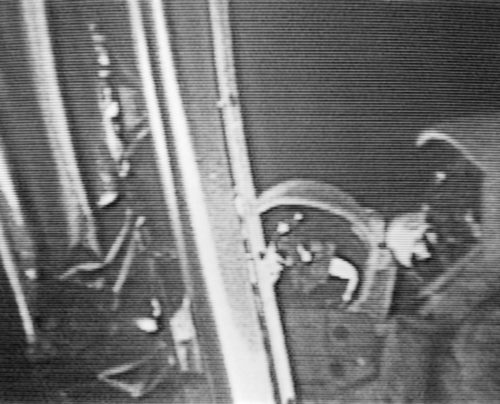
Grainy television image of Armstrong (left) and Aldrin on the surface. Photo Credit: NASA
The historic nature of the mission, indeed, made it inevitable that there would be a live telephone conversation with the astronauts’ head of state … and this was the event that both men blamed for their inability to get a good photograph of the First Man. According to Aldrin, seconds after Armstrong had taken the picture of him saluting the Stars and Stripes, Mission Control came on the line to say that President Nixon wished to talk to them. Apparently, Aldrin explained, the men were just about to swap the Hasselblad at that point, with the intention of taking some images of Armstrong, but were distracted by the request and the subject was later forgotten in the hurry to get everything done.
None of this, of course, even implies that the failure of either man to suggest taking a posed photograph of Armstrong was anything less than an oversight, and something neither man thought important at the time. “I was intimidated by the enormity of the situation,” Aldrin recalled later. Almost all of the pictures that he did take on the few occasions that he had possession of the Hasselblad were pictures which the flight plan called for him to take. A picture of Neil Armstrong was not on the list. Whatever the reality, at 11:47:47 p.m. CDT, Bruce McCandless called both men from their respective work.
“We’d like to get both of you in the field of view of the camera for a minute.” McCandless paused for a second, then continued: “Neil and Buzz, the President of the United States is in his office now and would like to say a few words to you. Over.”
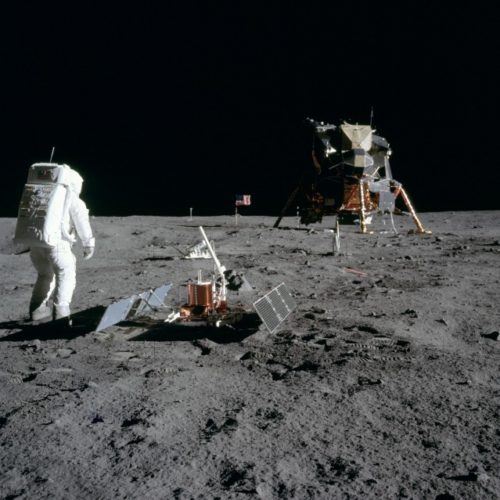
Buzz Aldrin at Tranquility Base. Photo Credit: NASA
“That would be an honor,” replied Armstrong.
“All right. Go ahead, Mr. President. This is Houston. Out.”
“Hello, Neil and Buzz,” Nixon began. “I’m talking to you by telephone from the Oval Room at the White House and this certainly has to be the most historic telephone call ever made. I just can’t tell you how proud we all are of what you have done. For every American, this has to be the proudest day of our lives. And for all people all over the world, I am sure they, too, join with Americans in recognizing what an immense feat this is. Because of what you have done, the heavens have become a part of man’s world. And as you talk to us from the Sea of Tranquility, it inspires us to redouble our efforts to bring peace and tranquility to Earth.”
Then, Nixon added the words which would bring a lump to many a throat and reinforce the reality that the human race had never been as unified as it was on the night of 20-21 July 1969: “For one priceless moment,” he said, “in the whole history of man, all the people on this Earth are truly one…one in their pride in what you have done and one in our prayers that you will return safely to Earth.”
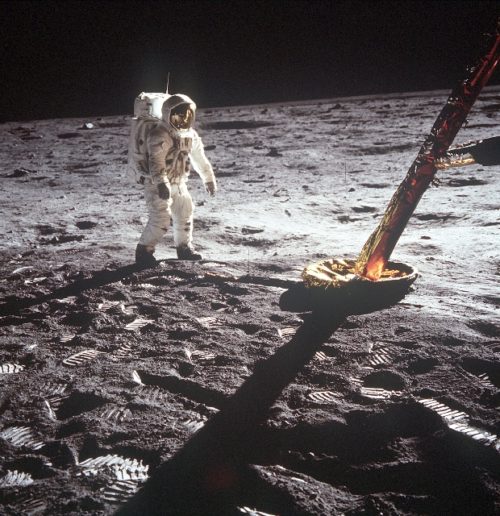
Since Armstrong had the camera for much of the Moonwalk, many of the photographs of are Aldrin…including this one. Photo Credit: NASA
Armstrong had been told by Deke Slayton, before launch, that there was a likelihood of some form of “special communication,” but it would seem that he had little idea who it might be. Judging from his response to the president—a polite “thank you,” a couple of instances of “it’s an honor,” and a brief note about his desire for “peace for all nations”—the brevity of Armstrong’s words would seem to suggest that both men felt unprepared, nervous, and decidedly ill at ease. His mother, Viola, could tell from her son’s voice that he was “emotionally shaken” and detected an unmistakable “tremor” in his tone.
With the unveiling of the plaque and the raising of the flag and the words with Nixon now behind them, the astronauts could set to work on the scientific side of their mission. Armstrong’s role during this time would be to collect samples of lunar material. “The geology community had hoped we would provide what they called “documented samples”,” he explained to James Hansen, “that is, samples whose emplacement was photographed prior to and after lifting the samples. Time did not permit our doing as much of that as we had hoped.”
As Armstrong labored with the samples, it was Aldrin’s responsibility to take the lead in setting up an automated research station on the surface. This Early Apollo Scientific Experiments Package (EASEP) was a forerunner of the more sophisticated Apollo Lunar Surface Experiments Package (ALSEP) which would be deployed by subsequent landing crews. As their time outside drew toward its close, one of the few changes in the plan came when Armstrong took it upon himself to go and photograph a yawning bowl-shaped crater about 180 feet (55 meters) east of Eagle which has since become known as “East Crater.” To get there as quickly as possible, he adopted a loping, foot-to-foot stride. He took half a dozen Hasselblad images, including outcroppings in the crater. By the time he returned to Eagle, his adventure had lasted a little over three minutes.
It was now 11:45 p.m. CDT and Aldrin had been advised that they had only a few minutes left before packing their equipment away. “There was just far too little time to do the variety of things that we would have liked to have done,” Armstrong explained in the post-flight press conference. “When you are in a new environment, everything around you is different and you have the tendency to look a little more carefully. In a simulation, you just picked up the rock and threw it into the pot!” Similarly, both men had seen rocks through Eagle’s cabin windows before they set foot on the surface—rocks which may have been pieces of lunar bedrock, potentially priceless geological specimens—which they did not have time to inspect, photograph, or collect. President Nixon’s telephone call had eaten more time out of their excursion, as had the assembly of the flag and the reading of the plaque.
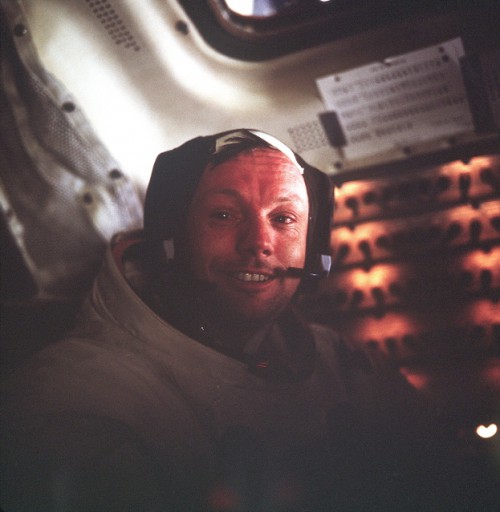
Pictured in the lunar module Eagle, shortly after his historic Moonwalk, Neil Armstrong would gain eternal fame which will endure through the ages. Photo Credit: NASA
As Aldrin headed up the ladder at 11:56 p.m. CDT, Armstrong sealed the last rock box. Then, working together, the two men hauled the film magazines, the Hasselblad and the two rock boxes into Eagle. At 12:09 a.m. CDT on 21 July, the First Man on the Moon jumped with both feet into Eagle’s footpad and set his gloved hands on the ladder; after a little more than two full hours, this was his last direct contact with lunar soil. He then crouched into a kind of deep-knee bend, getting his torso as close to the footpad as possible … and sprang himself upward, easily reaching the third rung. Two minutes later, he was back inside Eagle and Aldrin had pushed shut and sealed the hatch.
All in all, the world’s first excursion on alien soil had lasted two hours and 31 minutes from depressurisation to repressurization of the cabin, of which Armstrong had actually been on the surface for two hours and 14 minutes and Aldrin for one hour and 46 minutes.
After an uncomfortable night’s sleep, the two men left the Moon at 12:53 p.m. CDT on 21 July 1969, a little more than 21 hours since landing, and their ascent into lunar orbit and rendezvous with a happy Mike Collins aboard Columbia was charmed. Aldrin’s words to Collins as he passed the sample containers through the tunnel—“Get ready for these million-dollar boxes”—was entirely appropriate; for not only were the specimens of the Sea of Tranquility now priceless, but so too were the men themselves. From the moment the scorched and blackened cone of Columbia descended through the clouds and splashed into the Pacific Ocean on 24 July 1969, the names of Armstrong, Collins, and Aldrin would gain immortal status and their lives would never be the same again.
FOLLOW AmericaSpace on Facebook and Twitter!
Missions » Apollo »



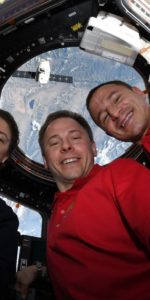
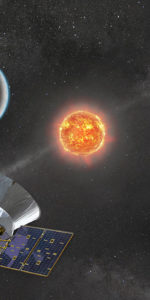
An excellent series on humanity’s greatest adventure. It adds yet another chapter to the Apollo saga. I would like to see some sort of comprehensive collection of “oral histories” of all the moonwalkers. Ben, than you.
Let’s see, two people on the moon and one is in the photo??? Now who should we give the photo credit to? Photo by: Neil Armstrong
Second Photo by:Buzz Aldrin